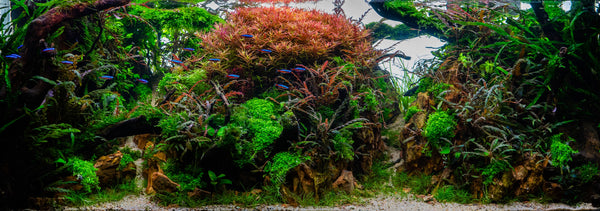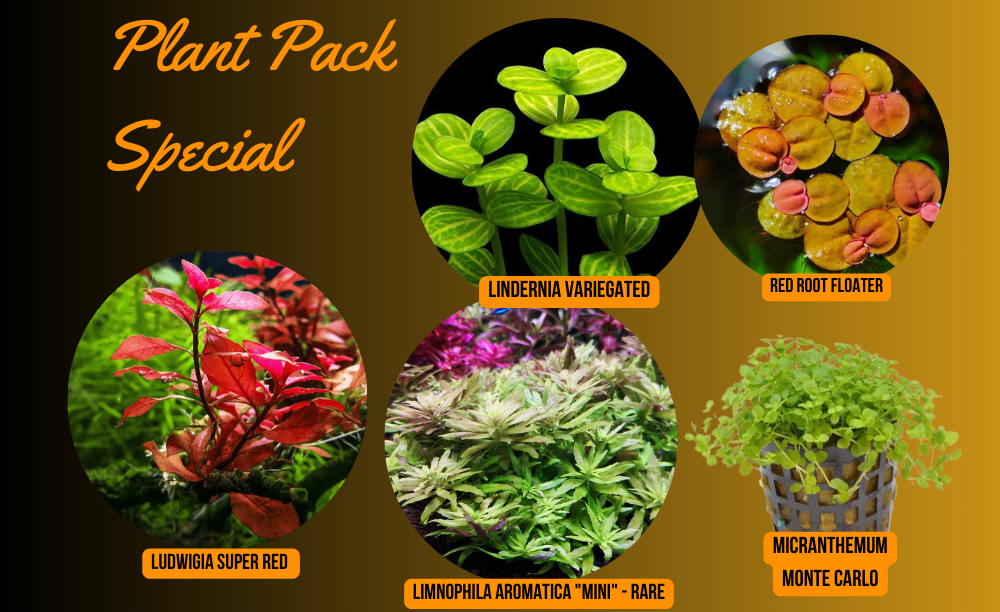Your Cart is Empty
we are now CLOSED FOR OUR ANNUAL BREAK
ANY NEW ORDERS WILL NOT BE SENT UNTIL EARLY JANUARY
***FREE SHIPPING ON ORDERS OVER $200***
we are now CLOSED FOR OUR ANNUAL BREAK
ANY NEW ORDERS WILL NOT BE SENT UNTIL EARLY JANUARY
***FREE SHIPPING ON ORDERS OVER $200***
Store

Caring for slow growing plants
3 min read
Anubias, Java Fern and Buce are attractive slow-growing plants, often praised for their hardy leaves and relative ease of care.
They flourish in a variety of water types and are tolerant of most lighting levels, growing happily even in very low light. Their slow growth speed makes their demand for nutrients low, requiring very little care for beautiful results. The tough leaves are also less likely to be eaten by herbivorous livestock, making them suitable for aquariums where other more delicate plants might be destroyed.
The sheer variety of anubias and buce species, subspecies and variants only adds to their popularity.
Not So Tough
While true that these plants are generally tough on the outside and easy to care for, they are still susceptible to algae and deficiencies, and can sometimes appear to die suddenly for no perceptible reason!
Algae
The slow growth and firm leaves of anubias, buce and java fern invites algae, as they provide a stable surface not only for the algae to grow on but for detritus to settle. Detritus on the leaves releases nutrients that algae loves. As the amount of detritus and algae on leaves increases, less light is received by the leaves and photosynthesis slows. Plant growth is impacted, the plant gets stressed – leading to even more algae.
Melting
Sometimes anubias or java fern seem to suddenly die off, even though they looked healthy right up until the last minute.
Because these plants have such a hardy exterior, they often don’t show signs of stress until it’s too late – they’ve been dying on the inside for a long time and eventually can’t go on.
This is often caused by photosynthesis being significantly impacted, whether that’s by algae or detritus on leaves or reduced lighting (from being shaded or a change in lighting/photoperiod). Another primary cause is a change in fertilisation or water change schedule.
Because the plants grow and adapt slowly to these changing conditions, the effects won’t be seen until long after the changes have been made. The “delayed response” means your java fern/anubias may have been dying slowly for a long time, and eventually reaches a point where the exterior of the plant is affected, causing the typical “melt”.
Disease
While true that melting is most commonly caused by a change in conditions, java fern and anubias can also be damaged by a disease affecting their rhizome and root systems. The rhizome, roots or both start to rot away, eventually destroying the entire plant.
Keeping slow-growers healthy
To keep your plants as healthy as possible, there are a few things you can do.
A regular maintenance schedule goes a long way. This includes siphoning of detritus and gentle brushing of leaves to remove accumulated waste along with regular water changes. Ensuring aquarium water flow is adequate will also reduce the amount of detritus settling.
Otherwise healthy leaves that have been affected by algae can be treated with LCA Carbon Plus or LCA Triple B. Leaves that are too damaged should be removed entirely as they won’t recover.
Revise your lighting or plant placement to improve their photosynthesis, or reduce lighting intensity if your leaves are getting too much. Slow growers don’t need much to be happy, and too much light will invite algae, especially GSA.
If you suspect disease is affecting your plants rather than improper care, you can confirm it with a quick visual inspection. Keep an eye on the rhizomes – if they appear to bulge uncharacteristically, or are discoloured (white/brown) or soft (think of a carrot that’s been left in the fridge too long), there’s a good chance disease is taking hold. Trim off any affected portions of rhizome and discard. Observe the rhizome over a few weeks for any further signs of damage and remove as necessary.
If the roots are diseased, roots or their tips will become discoloured (brown/white/yellow/translucent) while the rest of the plant appears mostly normal. As the disease progresses, the rest of the plant will be affected as well, showing typical signs of plant stress as it becomes unable to absorb nutrients. Again, remove and discard as much affected plant material as possible.
Remember, slow growing plants are also slow to show signs of change – make adjustments and observe for changes in appearance and new growth.
From The LCA Team
Every Solution For Your Aquarium
They flourish in a variety of water types and are tolerant of most lighting levels, growing happily even in very low light. Their slow growth speed makes their demand for nutrients low, requiring very little care for beautiful results. The tough leaves are also less likely to be eaten by herbivorous livestock, making them suitable for aquariums where other more delicate plants might be destroyed.
The sheer variety of anubias and buce species, subspecies and variants only adds to their popularity.
Not So Tough
While true that these plants are generally tough on the outside and easy to care for, they are still susceptible to algae and deficiencies, and can sometimes appear to die suddenly for no perceptible reason!
Algae
The slow growth and firm leaves of anubias, buce and java fern invites algae, as they provide a stable surface not only for the algae to grow on but for detritus to settle. Detritus on the leaves releases nutrients that algae loves. As the amount of detritus and algae on leaves increases, less light is received by the leaves and photosynthesis slows. Plant growth is impacted, the plant gets stressed – leading to even more algae.
Melting
Sometimes anubias or java fern seem to suddenly die off, even though they looked healthy right up until the last minute.
Because these plants have such a hardy exterior, they often don’t show signs of stress until it’s too late – they’ve been dying on the inside for a long time and eventually can’t go on.
This is often caused by photosynthesis being significantly impacted, whether that’s by algae or detritus on leaves or reduced lighting (from being shaded or a change in lighting/photoperiod). Another primary cause is a change in fertilisation or water change schedule.
Because the plants grow and adapt slowly to these changing conditions, the effects won’t be seen until long after the changes have been made. The “delayed response” means your java fern/anubias may have been dying slowly for a long time, and eventually reaches a point where the exterior of the plant is affected, causing the typical “melt”.
Disease
While true that melting is most commonly caused by a change in conditions, java fern and anubias can also be damaged by a disease affecting their rhizome and root systems. The rhizome, roots or both start to rot away, eventually destroying the entire plant.
Keeping slow-growers healthy
To keep your plants as healthy as possible, there are a few things you can do.
A regular maintenance schedule goes a long way. This includes siphoning of detritus and gentle brushing of leaves to remove accumulated waste along with regular water changes. Ensuring aquarium water flow is adequate will also reduce the amount of detritus settling.
Otherwise healthy leaves that have been affected by algae can be treated with LCA Carbon Plus or LCA Triple B. Leaves that are too damaged should be removed entirely as they won’t recover.
Revise your lighting or plant placement to improve their photosynthesis, or reduce lighting intensity if your leaves are getting too much. Slow growers don’t need much to be happy, and too much light will invite algae, especially GSA.
If you suspect disease is affecting your plants rather than improper care, you can confirm it with a quick visual inspection. Keep an eye on the rhizomes – if they appear to bulge uncharacteristically, or are discoloured (white/brown) or soft (think of a carrot that’s been left in the fridge too long), there’s a good chance disease is taking hold. Trim off any affected portions of rhizome and discard. Observe the rhizome over a few weeks for any further signs of damage and remove as necessary.
If the roots are diseased, roots or their tips will become discoloured (brown/white/yellow/translucent) while the rest of the plant appears mostly normal. As the disease progresses, the rest of the plant will be affected as well, showing typical signs of plant stress as it becomes unable to absorb nutrients. Again, remove and discard as much affected plant material as possible.
Remember, slow growing plants are also slow to show signs of change – make adjustments and observe for changes in appearance and new growth.
From The LCA Team
Every Solution For Your Aquarium
Subscribe
Sign up to get the latest on sales, new releases and more …

Join Us
Join our Facebook group and benefit from the knowledge of
Australia’s largest community of planted aquarium enthusiasts!







